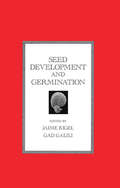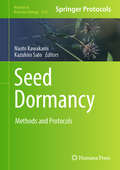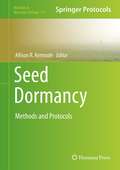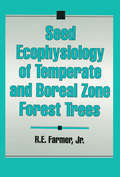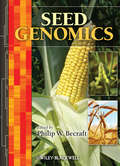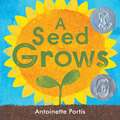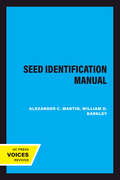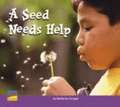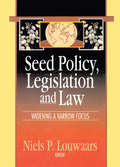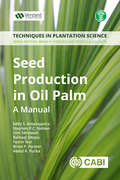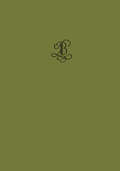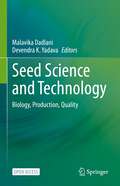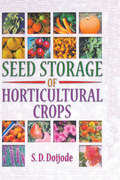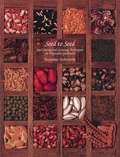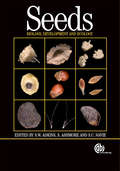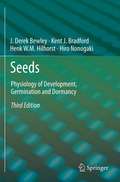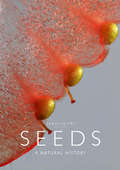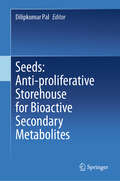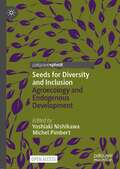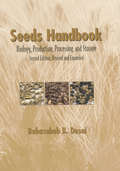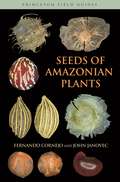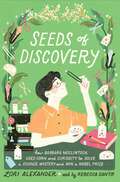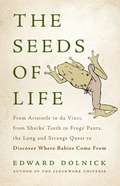- Table View
- List View
Seed Development and Germination (Books In Soils, Plants, And The Environment Ser. #41)
by Jaime Kigel Gad GaliliThis text is intended for plant physiologists, molecular biologists, biochemists, biotechnologists, geneticists, horticulturalists, agromnomists and botanists, and upper-level undergraduate and graduate students in these disciplines. It integrates advances in the diverse and rapidly-expanding field of seed science, from ecological and demographic aspects of seed production, dispersal and germination, to the molecular biology of seed development. The book offers a broad, multidisciplinary approach that covers both theoretical and applied knowledge.
Seed Dormancy: Methods and Protocols (Methods in Molecular Biology #2830)
by Naoto Kawakami Kazuhiro SatoThis volume provides basic and state-of-the-art methods for fundamental seed research and practical application. Chapters detail recent seed dormancy studies, basic methods for germination and longevity, seed imaging, sugar, chromatin analyses, QTL analysis, and GWAS protocols for diploid and complex hexaploid species. Written in the highly successful Methods in Molecular Biology series format, chapters include introductions to their respective topics, lists of the necessary materials and reagents, step-by-step, readily reproducible laboratory protocols, and key tips on troubleshooting and avoiding known pitfalls. Authoritative and cutting-edge, Seed Dormancy: Methods and Protocols aims to ensure successful results in the further study of this vital field.
Seed Dormancy
by Allison R. KermodeUnderstanding seed-related processes is of major social, environmental, and economic concern. The viability and vigor of seeds are the very basis for sustainable agriculture and forestry, and comprehending the molecular and cellular events underlying these processes will become increasingly important to many economical sectors and for species that provide the world's food supply. Seed Dormancy: Methods and Protocols covers analytical methods and approaches which have already lead to significant advances in the understanding of seed dormancy and germination. Chapters cover explanations of processes leading to the induction, maintenance, and termination of seed dormancy, the classification of different dormancy types, as well as an overview of protocols used for dormancy-termination of seeds of conifer species. This volume emphasizes methods essential for abscisic acid (ABA) analyses, including methods that have been important for receptor identification, analyses of ABA-catabolizing enzymes (the 8'-hydroxylases), and identification of novel signal transduction components, interacting partners, and/or response factors. The volume closes by addressing the development of new technologies, including spectroscopic methods (some of which allow for non-destructive sampling) as well as highly effective tissue-printing methods for seed dormancy research. Written in the successful Methods in Molecular BiologyTM series format, chapters include introductions to their respective topics, lists of the necessary materials and reagents, step-by-step, readily reproducible protocols, and notes on troubleshooting and avoiding known pitfalls. Authoritative and easily accessible, Seed Dormancy: Methods and Protocols features detailed methods that will prove invaluable for both applied and fundamental seed research.
Seed Ecophysiology of Temperate and Boreal Zone Forest Trees
by RobertE. FarmerThis is the first truly modern book solely devoted to seed reproduction of forest trees-from flowering to establishment, with emphasis on the interaction of environment with physiological processes.Focus is on seed function in natural settings and the application of information to natural regeneration of forests. This easy-to-read text addresses important principles and provides in-depth coverage of existing literature.Presentation of the information is organized to allow for a natural development of the main theme with full explanations of such important components as seed production, dispersal and germination, as well as the integral parts played by water, temperature, light, chemicals, animals, pathogens and aging.A highly useful book for investigators, practitioners or students.
Seed Endophytes: Biology and Biotechnology
by Satish Kumar Verma James Francis White JrThis book focuses on the importance and roles of seed microbiomes in sustainable agriculture by exploring the diversity of microbes vectored on and within seeds of both cultivated and non-cultivated plants. It provides essential insights into how seeds can be adapted to enhance microbiome vectoring, how damaged seed microbiomes can be assembled again and how seed microbiomes can be conserved. Plant seeds carry not only embryos and nutrients to fuel early seedling growth, but also microbes that modulate development, soil nutrient acquisition, and defense against pathogens and other stressors. Many of these microbes (bacteria and fungi) become endophytic, entering into the tissues of plants, and typically exist within plants without inducing negative effects. Although they have been reported in all plants examined to date, the extent to which plants rely on seed vectored microbiomes to enhance seedling competitiveness and survival is largely unappreciated. How microbes function to increase the fitness of seedlings is also little understood. The book is a unique and important resource for researchers and students in microbial ecology and biotechnology. Further, it appeals to applied academic and industrial agriculturists interested in increasing crop health and yield.
Seed Genomics
by Philip W. BecraftThis up-to-date review of seed genomics, from basic seed biology to practical applications in crop science, provides a thorough background understanding of seed biology from a basic science perspective. A valuable resource for advanced graduate students, post-docs, researchers and professionals in the Plant and Crop Sciences, this book brings together top researchers in the field to cover three general themes: genomic approaches to studying seeds, genomic analysis of basic seed biology, and crop seed genomics.A valuable resource for advanced graduate students, post-docs, researchers and professionals in the Plant and Crop Sciences
A Seed Grows
by Antoinette Portis“An educational picture book about the life cycle of o sunflower.”
Seed Identification Manual
by Alexander C. Martin William D. BarkleyThis title is part of UC Press's Voices Revived program, which commemorates University of California Press’s mission to seek out and cultivate the brightest minds and give them voice, reach, and impact. Drawing on a backlist dating to 1893, Voices Revived makes high-quality, peer-reviewed scholarship accessible once again using print-on-demand technology. This title was originally published in 1961.This title is part of UC Press's Voices Revived program, which commemorates University of California Press’s mission to seek out and cultivate the brightest minds and give them voice, reach, and impact. Drawing on a backlist dating to 1893, Voices Revived</DIV
A Seed Needs Help
by Katherine Scraper David HaggertyIn this book, explore the things a seed needs to grow.
Seed Policy, Legislation and Law: Widening a Narrow Focus
by Neils P LouwaarsLearn what it takes to create and implement a truly successful seed policy!This unique book brings together international experts on seed policy and law. While other books approach the subject from the perspective of seed industry development and privatization, Seed Policy, Legislation, and Law makes clear that a successful national seed
Seed Production in Oil Palm: A Manual (Techniques in Plantation Science)
by Eddy S Kelanaputra Stephen P. Nelson Umi Setiawati Baihaqi Sitepu Fazrin Nur Brian Forster Abdul R. PurbaThis is a practical guide to seed germination in oil palm for both breeding and genetic studies as well as commercial seed production. Oil palm is the top oil crop in the world and this manual provides step-by-step illustrated methods, written by practitioners actively engaged in oil palm seed production and breeding. Presenting sound practices based on scientific innovation and knowledge, this guide brings together the many aspects of seed germination in oil palm in one place. Promoting green, eco-friendly agriculture, this book covers: Health and safety considerations Pollination and harvesting Seed preparation, viability testing and moisture testing Seed processing for commercial production and breeding Based on experience and protocols, this is an invaluable manual for students and researchers in agriculture, plant breeders, growers and end users interested in the practicalities of oil palm seed production. It is also a valuable resource for training, for those entering a career in oil palm and as a reference for managers , to ensure best practices in maximising sustainability and production of this important crop.
Seed Production in Oil Palm: A Manual (Techniques in Plantation Science #1)
by Eddy S Kelanaputra Steven P. Nelson Umi Setiawati Baihaqi Sitepu Fazrin Nur Brian Forster Abdul R. Purba Peter D. CaligariThis is a practical guide to seed germination in oil palm for both breeding and genetic studies as well as commercial seed production. Oil palm is the top oil crop in the world and this manual provides step-by-step illustrated methods, written by practitioners actively engaged in oil palm seed production and breeding. Presenting sound practices based on scientific innovation and knowledge, this guide brings together the many aspects of seed germination in oil palm in one place. Promoting green, eco-friendly agriculture, this book covers: Health and safety considerations Pollination and harvesting Seed preparation, viability testing and moisture testing Seed processing for commercial production and breeding Based on experience and protocols, this is an invaluable manual for students and researchers in agriculture, plant breeders, growers and end users interested in the practicalities of oil palm seed production. It is also a valuable resource for training, for those entering a career in oil palm and as a reference for managers , to ensure best practices in maximising sustainability and production of this important crop.
Seed Regeneration in Cross-pollinated Species
by E. PorcedduThis book deals with the practical aspects in regeneration of field crop plants; regeneration of pasture plants; and regeneration of horticultural plants. It discusses the methods to increase seed stocks of cross-pollinated species.
Seed Science and Technology: Biology, Production, Quality
by Malavika Dadlani Devendra K. YadavaThis open-access edited book is a collection of 17 chapters, synthesized primarily from the lectures delivered by eminent Indian and international experts during a series of capacity-building programmes organised in India during 2020 and 2021 under the aegis of 'Indo-German Cooperation on Seed Sector Development', a component of the Bilateral Cooperation between the Governments of India and Germany. Seed Science and Technology, a multi-disciplinary subject, is advancing rapidly keeping pace with the development of improved plant varieties and other climate-resilient technologies. Knowledge of the underlying biological processes and application of appropriate technologies for variety maintenance and seed production; quality assurance, testing and enhancement; processing, packaging and storage etc., are important in a seed programme. Chapters presented in the book is a blend of basic seed biology covering seed development, maturation, dormancy, germination, vigour and invigoration, and seed deterioration; variety maintenance and production of genetically pure seed of open-pollinated and hybrid varieties in a few key field crops and vegetables, and fundamentals of seed processing, packaging and storage; and seed quality assurance systems followed in different countries; testing the essential components of seed quality including seed health, application of molecular technologies for precision in testing, and enhancement of seed quality. It concludes by identifying the key areas of future seed research and technology development. The book covers the fundamentals and recent advances of seed science and technology with the latest research information and an exhaustive and updated list of references on different topics. It is expected to benefit the students as well as the scientists, faculty members and seed sector professionals, working in the public and private seed sectors, certification authorities and seed producing agencies in India, and elsewhere.
Seed Storage of Horticultural Crops
by S.d. DoijodeMaintain viability with these techniques for proper seed storage!Healthy, viable seeds are the foundation for sustainable crop production, while poorly kept seeds can result in low germination and crop loss. Seed Storage of Horticultural Crops suggests appropriate strategies to help farmers and breeders store seeds of all kinds.
Seed To Seed: Seed Saving And Growing Techniques For The Vegetable Gardener
by Suzanne Ashworth Kent WhealySeed to Seed is a complete seed-saving guide that describes specific techniques for saving the seeds of 160 different vegetables. This book contains detailed information about each vegetable, including its botanical classification, flower structure and means of pollination, required population size, isolation distance, techniques for caging or hand-pollination, and also the proper methods for harvesting, drying, cleaning, and storing the seeds. Seed to Seed is widely acknowledged as the best guide available for home gardeners to learn effective ways to produce and store seeds on a small scale. The author has grown seed crops of every vegetable featured in the book, and has thoroughly researched and tested all of the techniques she recommends for the home garden. This newly updated and greatly expanded Second Edition includes additional information about how to start each vegetable from seed, which has turned the book into a complete growing guide. Local knowledge about seed starting techniques for each vegetable has been shared by expert gardeners from seven regions of the United States-Northeast, Mid-Atlantic, Southeast/Gulf Coast, Midwest, Southwest, Central West Coast, and Northwest.
Seeds: Biology, Development and Ecology
by Steve W. AdkinsProviding comprehensive coverage of the latest seed science research including germination, dormancy, development, and desiccation tolerance, this book also details the most advanced methods and practices in seed biology, ecology and technology.
Seeds
by Kent Bradford J. Derek Bewley Henk Hilhorst Hiroyuki NonogakiThis updated and much revised third edition of Seeds: Physiology of Development, Germination and Dormancy provides a thorough overview of seed biology and incorporates much of the progress that has been made during the past fifteen years. With an emphasis on placing information in the context of the seed, this new edition includes recent advances in the areas of molecular biology of development and germination, as well as fresh insights into dormancy, ecophysiology, desiccation tolerance, and longevity. Authored by preeminent authorities in the field, this book is an invaluable resource for researchers, teachers, and students interested in the diverse aspects of seed biology.
Seeds: A Natural History
by Carolyn FryFrom the magnificence of a towering redwood to the simple elegance of a tiny dandelion, seed-bearing plants abound on planet Earth. The sheer diversity of plants thriving today is largely thanks to the evolution of the seed, as this made plants resilient to environmental changes by enabling them to await optimum conditions for growth before springing to life. In a time of declining biodiversity, studying seeds is now helping scientists preserve this plant diversity for future generations. With Seeds, Carolyn Fry offers a celebration of these vital but unassuming packages of life. She begins with a sweeping tour through human history, designed to help us understand why we should appreciate and respect these floral parcels. Wheat, corn, and rice, she reminds us, supply the foundations of meals eaten by people around the world. Countless medicines, oils, clothing materials, and building supplies are available only because of the versatility and variety of seed-bearing plants. Fry then provides a comprehensive history of the evolution of seeds, explaining the myriad ways that they have adapted, survived, and thrived across the globe. Delving deeper into the science of seeds, she reveals the fascinating processes of dormancy, reproduction, germination, and dispersal, and showcases the estimable work conservationists are doing today to gather and bank seeds in order to prevent species from going extinct. Enriched by a stunning array of full-color images, Seeds offers a comprehensive exploration of some of the most enduring and essential players in the natural world.
Seeds: Anti-proliferative Storehouse for Bioactive Secondary Metabolites
by Dilipkumar PalThis book presents extensive and up-to-date information on the anti-proliferative properties of various plant seeds for their application in pharmaceutical industry and medicinal research. This information is imperative for understanding and developing high quality products from the seeds.The book provides insights about anticancer and antitumour activities present in seeds. Different chapters cover the traditional knowledge as well as recent innovations in various seeds, such as prune, pumpkin, grape fruit, sesame, sunflower, bitter gourd, papaya, mango, apple, black plum, cumin, water melon, musk melon, cotton, carambola, pear, cardamon, moringa, wallich, Chinese cabbage, pistachio, etc. and their bioactivities for the applications in cancer and malignancy proliferation. The book introduces the readers to seed as a bioactive compound, and delineates the various health effects. It further explains the relation between the different metabolites and their effect on cell proliferation. Finally the book goes on to explain different seeds and their specific anti-cancer properties. This book is useful for students and researchers of pharmacology, botany and cancer research. It also caters to industry experts in pharmaceutical sciences.
Seeds for Diversity and Inclusion: Agroecology and Endogenous Development
by Yoshiaki Nishikawa Michel PimbertThis open access book will contribute to a more nuanced debate around seed system resilience that goes beyond the dominant dichotomous conceptualization of seed governance often characterized as traditional vs modern, subsistence vs commercial, or local vs global. While reflecting on the expanding oligopoly in the current seed system, the authors argue that such classifications limit our ability to critically reflect on and acknowledge the diverse approaches through which seed governance is practiced around the world, at various scales, creating a mosaic of dynamic complementarities and autonomies. The authors also highlight the importance of this much needed dialogue through case studies of seed governance approaches and practices found in and around Japan.
Seeds Handbook: Processing And Storage
by Babasaheb B. DesaiRevised and expanded throughout, this latest edition of the bestselling Seeds Handbook: Biology, Production, Processing, and Storage includes valuable information on all areas of seed biology, production, and processing. The author, one of the most respected and prolific scientists in the field, identifies current developments in seed testing and c
Seeds of Amazonian Plants (Princeton Field Guides #66)
by Fernando Cornejo John JanovecSeeds of Amazonian Plants is the first field guide to treat the extraordinary diversity of seeds and diaspores of plants commonly encountered in the Amazon and other lowland moist forests of the American tropics. This stunningly illustrated guide features an easy-to-use whole-plant approach to seed identification that provides detailed descriptions not only of the seeds but also of the habit, trunk, bark, leaves, infructescence, and fruit of Amazonian plants, as well as information about the known uses and distribution of each genus. Presenting these descriptions together with 750 full-color photos and a unique identification key, this premier field guide enables users to identify seeds of 544 genera and 131 families of plants. The most comprehensive field guide to Amazonian seeds Features 750 full-color photos that make identification easy Covers 544 genera and 131 families of Amazonian plants Describes seeds, habit, trunk, bark, leaves, infructescence, and fruit Includes unique seed identification key Compact, portable, and beautifully illustrated--the ideal field guide
Seeds of Discovery: How Barbara McClintock Used Corn and Curiosity to Solve a Science Mystery and Win a Nobel Prize
by Lori AlexanderThe quirky and singular Nobel Prize winner Barbara McClintock, a founder of modern genetics who did things her own way, is honored in this lively young STEM biography by Sibert Honor winner Lori Alexander. Celebrating the power of curiosity and the rewards of tenacity, this engaging and highly illustrated biography introduces young readers to the field of genetics. As a rare female botanist in early twentieth-century America, Barbara McClintock never let other people’s notions of what was proper slow her down. When she faced doubting colleagues and unsupportive institutions, she drove across the United States, climbed through windows, and even slept in her laboratory to conduct her research. In so doing, she helped pave the way for future scientific discoveries that can cure diseases and save lives—and won a Nobel Prize in the process!Back matter includes a timeline, glossary, source notes, and further reading.
The Seeds of Life: From Aristotle to da Vinci, from Sharks' Teeth to Frogs' Pants, the Long and Strange Quest to Discover Where Babies Come From
by Edward DolnickWhy cracking the code of human conception took centuries of wild theories, misogynist blunders, and ludicrous mistakes Throughout most of human history, babies were surprises. People knew the basics: men and women had sex, and sometimes babies followed. But beyond that the origins of life were a colossal mystery. The Seeds of Life is the remarkable and rollicking story of how a series of blundering geniuses and brilliant amateurs struggled for two centuries to discover where, exactly, babies come from. Taking a page from investigative thrillers, acclaimed science writer Edward Dolnick looks to these early scientists as if they were detectives hot on the trail of a bedeviling and urgent mystery. These strange searchers included an Italian surgeon using shark teeth to prove that female reproductive organs were not 'failed' male genitalia, and a Catholic priest who designed ingenious miniature pants to prove that frogs required semen to fertilize their eggs.A witty and rousing history of science, The Seeds of Life presents our greatest scientists struggling-against their perceptions, their religious beliefs, and their deep-seated prejudices-to uncover how and where we come from.
